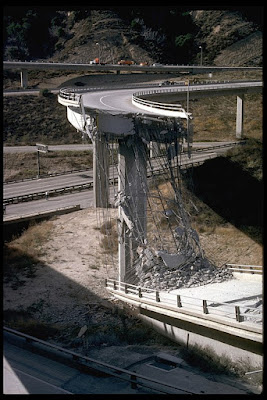Earthquake Hazards: Damaged Infrastructure
Damaged buildings are what most people expect in the aftermath of a strong earthquake. However, roads, bridges, water supply, electrical grid, railways, airports, and other structures and facilities that support our modern life--the infrastructure and backbone of our society--are all at risk.
What happens when damaged infrastructure makes life anything but normal?
The first effect is when damaged infrastructure--including various modes and systems of transportation--delays response time by first responders, medical assistance, fire fighting, and other assistance. This delay not only affects local help but also hinders aid from outside sources. Transportation of food and supplies will be slowed or even stopped. Damaged roads, airports, train stations, and ports will all affect the flow of aid, materials, food, and outside assistance to the area of impact.
To make matters worse, the harder hit areas will have their infrastructure hit harder, further complicating rescue, assistance, and other efforts.
If the electrical grid goes down, so does the option to use any electrically powered device that requires power from the grid. In the summer, this means air conditioning probably won’t be an option. Batteries, solar power, generators, and alternative sources of electricity could provide needed power for some systems.
Unfortunately most backup power systems, such as those used for facilities like hospitals, care centers, or even data centers, are not designed to run more than a few days, usually due to the lack of sufficient fuel storage.
What happens to patients or the elderly who are dependent on electrically powered equipment? What happens when vital computer systems cannot be used to monitor critical health conditions, or to access vital patient records for medication and other health information?
After the 6.7 magnitude Northridge earthquake, about 2 million people were without power. Roadways were damaged or sections destroyed, impeding transportation and rescue efforts. The infrastructure damage, residential, and business losses of the 1994 quake exceeded $40 billion. If a similar earthquake were to happen, residential damage alone would likely top $79 million. The USGS estimates a 93% change of a similar earthquake happening within the next 30 years. (link CBSN Los Angeles 23 Years Later, Costs For Another Devastating Northridge-Style Quake Skyrocket)
Water Infrastructure
Damaged infrastructure includes the various utilities that make our lives more comfortable. A damaged electric grid is usually more quickly repaired than another, more critical infrastructure system: the water supply.
We take our utilities—water, electric, gas—for granted, and easily overlook them, until they're off. A short blackout of a few hours is a major inconvenience for most people in the United States. In most earthquake scenarios I've read electricity is relatively quickly restored in the aftermath, where most affected homes and businesses have service restored in a matter of weeks.
Water is another story.
The other day I went home for lunch and was going to wash a fresh tomato for my sandwich. I turned on the kitchen faucet and...nothing. I asked my wife if she knew why the water was off. She didn't and it'd been working just a short time earlier.
Turns out the city shut off the water to the neighborhood for a short time (they were finding a leak) and it was turned back on less than five minutes later.
A very minor inconvenience. If the water had been off for longer we would've started using some of our water storage. Thankfully we didn't get to that, though we have in the past when water's been off for an extended time.
But what happens if the water system is damaged from an earthquake?
Here's the worrisome part. Damaged water infrastructure takes much, much longer to restore than electricity. In some of the earthquake scenarios I've read it's expected to take more than 90 days to restore water to most of the affected area. Even after that there will still be many without potable water.
How long could you manage your household if your water supply lost? Can you make it a week? Month? What about 90 days?
How will you get water?
Not just for drinking but for cooking, cleaning, and hygiene purposes as well. Most people don’t store emergency food, and even less have considered adequate water storage. Those who do have an emergency water supply might have a couple weeks’ worth, maybe as much as month. But, what about three months’ worth?
In upcoming posts I'll summarize some of the earthquake scenarios I studied. These scenarios were developed in conjunction with the Federal Emergency Management Agency and various state agencies. Some of the most eye-opening factors have to do with anticipated damaged infrastructure. Here's a big hint towards preparedness: Those who believe a 72-hour kit will suffice may end up getting a very rude wake-up call. It's certainly better than nothing, but not nearly enough for what you should expect.



Comments
Post a Comment